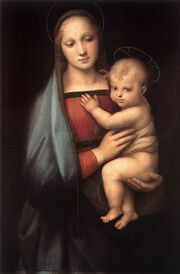
The Holy Infant
Sacred Language or Liturgical Language is the language of the Catholic Church. The official language of the Church is Latin,[1] but each of the 23 churches have their own languages. These include Latin, Aramaic, Syriac, West Syriac, Malayalam, Arabic, Egyptian Coptic, Geez, Classical Armenian, Albanian, Old Slavonic, Church Slavonic, Greek, Hungarian, English, Italo-Armenian, Spanish, Portugese, Romanian, and the vernacular of the Ukraine - Latin being the language of the Western Church and Eastern Churches and all the rest also being the languages of their respected Eastern Churches.[2] The oldest languages of the Church are Hebrew, Greek and Latin, which were used to write the Holy Inscription,[3] although none of these languages have survived to this day (see Aramaic, Greek and Latin below). Jesus Christ knew every language from Incarnation as God, but he had to learn how to speak and write from Incarnation as Man.[4]
Latin[]
Otherwise known as Church Latin or Modern Latin, Latin is distinct from the Classical or Ancient Latin used in Jesus' time. Still, Latin is the official language of the Holy See.[5]
Used In: The Roman Rite, Anglican Use, Moazrabic Rite, Ambrosian Rite, Bragan Rite, Dominican Rite, Carmelite Rite, and Carthusian Rite.
Learn Latin: Simplicissimus (PDF)
Aramaic[]
Otherwise known as Modern Aramaic, Aramaic is distinct from the Classical Aramaic (Hebrew) used in Jesus' time, which in turn was distinct from the Hebrew used by the Israelites.[6]
Used In: The Maronite Rite.
Learn Aramaic: Introductory Lessons in Aramaic (PDFs)
Syriac[]
Otherwise known as Church Syriac, Syriac is a dialect of Aramaic, distinct from the Classical Syriac used in Jesus' time and preserved in ancient writings which are kept by Antioch.[7]
Used In: The Chaldean Rite and Syro-Malabarese Rite.
Learn Syriac: Syriac Alphabet
West Syriac[]
Otherwise known as Western Middle Syriac, West Syriac is a type of Syriac, which, just like Syriac, is distinct from Classical Syriac and is preserved in writings kept by Antioch.[8]
Used In: The Syriac Rite and Malankarese Rite.
Learn West Syriac: Syriac Dictionary in Four Languages
Malayalam[]
A Dravidian language, Malayalam is said to be ancient and have no connection to any other language except for the other Dravidian languages. There is no mention of it until the 1500's.[9]
Used In: The Malankarese Rite and Syro-Malabarese Rite.
Learn Malayalam: Malayalam Audio Books & Educations
Arabic[]
Otherwise known as Modern Arabic, Arabic is distinct from the Classical Arabic developed from the dialects of Arabic tribes in Saudi Arabia during the Middle Ages for Islam.[10]
Used In: The Chaldean Rite, Coptic Rite, and Melkite Rite.
Learn Arabic: Arabic Writing, Counting, & More
Egyptian Coptic[]
Coptic is the final stage of the Egyptian language and writing system, which flourished in the 2nd century thanks to the Desert Fathers, due to the Diocletian persecution of Christians.[11]
Used In: The Coptic Rite.
Learn Coptic: Coptic (St-Takla)
Geez[]
Ge'ez originated in Arabia and was later developed in Ethiopia and Eritrea. It is only used in the Christian and Jewish liturgies of Ethiopia, and even than, the vernacular can substitute.[12]
Used In: The Ethiopian Rite.
Learn Geez: Ge'ez (Ethiopic) Script
Classical Armenian[]
Otherwise known as Old Armenian or Church Armenian, Classical Armenian is the oldest form of Armenian known. It was started in the 5th century, and has evolved into Grabar Armenian.[13]
Used In: The Armenian Rite.
Learn Armenian: Armenian Alphabet, Language, and Pronunciation
Albanian[]
Albanian is distinct from Old Albanian, which received considerable influence from Old Latin, Greek, and Slavonic yet was distinct from all three languages. However, it was closest to Slavic.[14]
Used In: The Albanian Rite.
Learn Albanian: Albanian - Tosk Dialect (Videos)
Old Slavonic[]
Not to be confused with Slavic itself, Ancient Slavonic was created by St. Cyril for the purpose of evangelization. As the first form of Slavic, it evolved into Church Slavonic.[15]
Used In: The Belarussian Rite, Bulgarian Rite, Krizevci Rite, Russian Rite, and Ukranian Rite.
Learn Old Slavonic: Old Church Slavonic Alphabet and Language
Church Slavonic[]
Church Slavonic evolved from Old Slavonic, replacing obscure words with vernacular words. It is mostly used in the liturgies of the Eastern Catholic Churches and Eastern Orthodox Churches.[16]
Used In: The Czech Rite, Ruthenian Rite, and Slovak Rite.
Learn Church Slavonic: Eastern Orthodox Slavonic Liturgical Texts
Greek[]
Otherwise known as Modern Greek, Greek is distinct from the Ancient Greek used in Jesus' time. The Greek codex (translation) of the Bible, called the Septuagint, contains Ancient Greek.[17]
Used In: The Greek Rite, Hungarian Rite, Italo-Albanian Rite and Melkite Rite.
Learn Greek: Learn Ancient Greek
Hungarian[]
Hungarian is an Ugric language that separated from its closest relatives about three thousand years ago, which means it started in about 1000 BC. The Turkic languages later influenced Hungarian.[18]
Used In: The Hungarian Rite.
Learn Hungarian: Hungarian Lessons
English[]
Used In:
Learn English:
Italo-Armenian[]
Used In:
Learn Italo-Armenian:
Spanish[]
Used In:
Learn Spanish:
Portugese[]
Used In:
Learn Portugese:
Romanian[]
Used In:
Learn Romanian:
Ukraine Vernacular[]
Used In:
Learn Ukraine vernacular:
Notes[]
- ↑ Certamen Vaticanum For Latin is in a way a universal language cutting across national boundaries and as such the Apostolic See still constantly makes use of it in letters and acts addressed to the whole Catholic family.
- ↑ http://www.catholicculture.org/culture/library/view.cfm?recnum=2786
- ↑ http://www.vatican.va/archive/ENG0839/_PXR.HTM#CO
- ↑ http://www.vatican.va/archive/ccc_css/archive/catechism/p122a3p1.htm#471
- ↑ http://en.wikipedia.org/wiki/Church_latin
- ↑ http://en.wikipedia.org/wiki/Neo-Aramaic_languages
- ↑ http://en.wikipedia.org/wiki/Syriac_language
- ↑ http://en.wikipedia.org/wiki/Syriac_language
- ↑ http://en.wikipedia.org/wiki/Malayalam
- ↑ http://en.wikipedia.org/wiki/Modern_Standard_Arabic
- ↑ http://en.wikipedia.org/wiki/Coptic_language
- ↑ http://en.wikipedia.org/wiki/Ge%27ez_language
- ↑ http://en.wikipedia.org/wiki/Classical_Armenian
- ↑ http://en.wikipedia.org/wiki/Albanian_language
- ↑ http://en.wikipedia.org/wiki/Old_Church_Slavonic
- ↑ http://en.wikipedia.org/wiki/Church_Slavonic
- ↑ http://en.wikipedia.org/wiki/Greek_language
- ↑ http://en.wikipedia.org/wiki/Hungarian_language